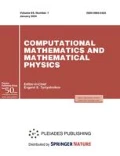Abstract
The nonstationary Navier–Stokes equations describing the instability of the boundary layer on a plate placed instantaneously in a subsonic flow are solved numerically using a scheme with 16th-order multioperator approximations. The problem is considered in the traditional formulation without introducing instability exciters. Unstable modes arise due to the controlled background of small perturbations of the exact solutions produced by the truncation errors of the scheme. The presented solutions describe a scenario in which packets of Tollmien–Schlichting waves of time-dependent intensity develop near the leading edge of the plate and propagate downstream with increasing amplitudes. The influence exerted by the spectral content of the dissipative part of the scheme on the wave numbers and the amplitudes of the wave packets is estimated. The correspondence between the instability development in the resulting solutions and the basic results of linear theory is discussed.












Similar content being viewed by others
REFERENCES
H. Schlichting, Boundary Layer Theory (McGraw-Hill, New York, 1968).
G. B. Schubauer and H. K. Skramstad, “Laminar-boundary-layer oscillations and transition on a flat plate,” NACA Rep. 909 (1948).
P. S. Klebanoff, K. D. Tidstrom, and L. M. Sargent, “Numerical simulation of transition in wall-bounded shear flows,” Annu. Rev. Fluid Mech. 23, 495–537 (1962).
M. Gaster and I. Grant, “An experimental investigation of the formation and development of a wavepacket in a laminar boundary layer,” Proc. R. Soc. London, Ser. A 347, 253–269 (1975).
Yu. S. Kachanov, V. V. Kozlov, and V. Ya. Levchenko, “Nonlinear development of a wave in a boundary layer,” Fluid Dyn. 12, 383–390 (1978).
V. I. Borodulin and Yu. S. Kachanov, “Formation and development of coherent structures in transitional boundary layer,” J. Appl Mech. Tech. Phys. 36 (4), 532–564 (1995).
L. Cleiser and T. A. Zang, “Numerical simulation of transition in wall-bounded shear flows,” Annu. Rev. Fluid Mech. 23, 495–537 (1991).
U. Rist and H. Fasel, “Direct numerical simulation of controlled transition in a flat-plate boundary layer,” J. Fluid Mech. 298, 211–248 (1995).
V. I. Borodulin, V. R. Gaponenko, Y. S. Kachanov, et al., “Late-stage transitional boundary-layer structures: Direct numerical simulation and experiment,” Theor. Comput. Fluid Dyn. 15, 317–337 (2002).
K. C. Yeo, X. Zhao, Z. Y. Wang, and K. C. Ng, “DNS of wavepacket evolution in a Blasius boundary layer,” J. Fluid Mech. 652, 333–372 (2010).
S. Bhaumik and T. Sengupta, “Receptivity to harmonic excitation following nonimpulsive start for boundary-layer flows,” AIAA J. 55, 3233–3238 (2017).
S. Muppidi and K. Mahesh, “DNS of transition in supersonic boundary layers,” AIAA Paper 2010-4440 (2010).
C. Liu and P. Lu, “DNS study on physics of late boundary layer transition,” AIAA Paper 2012-0083 (2012).
I. V. Egorov and A. V. Novikov, “Direct numerical simulation of laminar–turbulent flow over a flat plate at hypersonic flow speeds,” Comput. Math. Math. Phys. 56 (6), 1048–1064 (2016).
I. V. Egorov, A. V. Novikov, and A. V. Fedorov, “Direct numerical simulation of the laminar–turbulent transition at hypersonic flow speeds on a supercomputer,” Comput. Math. Math. Phys. 57 (8), 1335–1359 (2017).
M. V. Lipavskii and A. I. Tolstykh, “Tenth-order accurate multioperator scheme and its application in direct numerical simulation,” Comput. Math. Math. Phys. 53 (4), 455–468 (2013).
A. I. Tolstykh and D. A. Shirobokov, “Fast calculations of screech using highly accurate multioperators-based schemes,” Appl. Acoust. 74, 102–109 (2013).
A. I. Tolstykh and M. V. Lipavskii, “Instability and acoustic fields of the Rankine vortex as seen from long-term calculations with the tenth-order multioperators-based scheme,” Math. Comput. Simul. 147, 301–320 (2018).
A. I. Tolstykh and M. V. Lipavskii, “General scenario and fine details of compressible Gaussian vortex unforced instability,” Eur. J. Mech. B/Fluids 87, 161–170 (2021).
A. I. Tolstykh and D. A. Shirobokov, “Observing production and growth of Tollmien–Schlichting waves in subsonic flat plate boundary layer via exciters-free high fidelity numerical simulation,” J. Turbulence 21 (11), 632–649 (2020).
A. I. Tolstykh, “16th and 32nd multioperators based schemes for smooth and discontinuous solutions,” Commun. Comput. Phys. 45, 33–45 (2017).
A. I. Tolstykh, High Accuracy Compact and Multioperator Approximations for Partial Differential Equations (Nauka, Moscow, 2015) [in Russian].
Funding
The results presented in this work were obtained using the supercomputers at the Joint Supercomputer Center of the Russian Academy of Sciences, a branch of the Federal Research Center Scientific Research Institute for System Analysis of the Russian Academy of Sciences.
Author information
Authors and Affiliations
Corresponding authors
Ethics declarations
The authors declare that they have no conflicts of interest.
Additional information
Translated by I. Ruzanova
Rights and permissions
About this article
Cite this article
Tolstykh, A.I., Shirobokov, D.A. Excitation and Development of Instability in a Compressible Boundary Layer as Obtained in High-Order Accurate Numerical Simulation without Introducing Artificial Perturbations. Comput. Math. and Math. Phys. 62, 1180–1192 (2022). https://doi.org/10.1134/S0965542522070090
Received:
Revised:
Accepted:
Published:
Issue Date:
DOI: https://doi.org/10.1134/S0965542522070090


